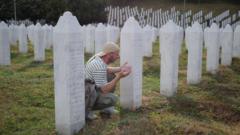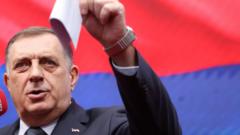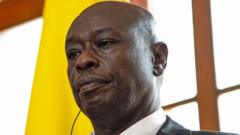In a haunting reminder of the past, the audience at Sarajevo's War Theatre recently experienced the emotional weight of the Srebrenica massacre through the world premiere of "Flowers of Srebrenica." This performance not only recounts the horrific events of July 1995, where over 8,000 Bosnian men and boys were killed by Bosnian Serb forces, but also serves as a lens to examine the lingering grief and divisions present in contemporary Bosnia and Herzegovina.
The massacre occurred during a United Nations-imposed safe zone in Srebrenica, where many Bosniaks sought refuge, believing they would be protected. Instead, Dutch troops were rendered ineffective, allowing Bosnian-Serb General Ratko Mladić to orchestrate one of modern history's deadliest war crimes. Bodies were disposed of in mass graves, only to be moved later to conceal the crime, leaving families in a prolonged search for closure—a pursuit that has been tragically illustrated through the art of theatre.
The performance resonated with the audience, yet reveals a stark reality; not all were honoring the victims. In Republika Srpska, which is predominantly Serb, political leaders continue to assert that genocide did not happen in Srebrenica, despite international legal recognition of the events as genocide. Lead actress Selma Alispahić expressed her dismay, reflecting on a hoped-for shift in attitudes after 30 years. The ongoing climate of denial complicates the narrative for survivors and families still grappling with unresolved pain.
Long-standing ethnic divisions remain a major obstacle to reconciliation. The Dayton Peace Agreement, designed to halt the violence, also entrenched these divisions within Bosnia and Herzegovina. The Federation is largely composed of Bosniaks and Croats, while Serbs inhabit Republika Srpska. This dichotomy not only divides the populace but also fuels the ambitions of political figures like Milorad Dodik, who often stirs ethnic sentiments for personal political gain. Recent legislation aimed at withdrawing from national institutions has escalated tensions, as international authorities fear it could threaten stability.
Public displays of remembrance for the victims are prevalent in Sarajevo, including the procession of remains identified for burial at the Potočari Cemetery. In stark contrast, such gestures are virtually absent in Republika Srpska, where sentiments surrounding the massacre are often dismissed or minimized. Key political voices from this region assert that attention needs to be balanced between all groups affected by the conflict.
Despite the prevalent denial from certain leaders, a large number continue to advocate for solidarity and remembrance. Community support for victims' families remains strong, highlighting a commitment to healing. However, for individuals like Mirela Osmanović, who lost family members in the massacre, the recent political climate evokes a fear akin to the tensions of the early 1990s.
As the conflicting narratives about Srebrenica persist, they highlight the challenges ahead for Bosnia and Herzegovina, indicating the road to healing will continue to be marred by political strife and deep-rooted ethnic divides.









